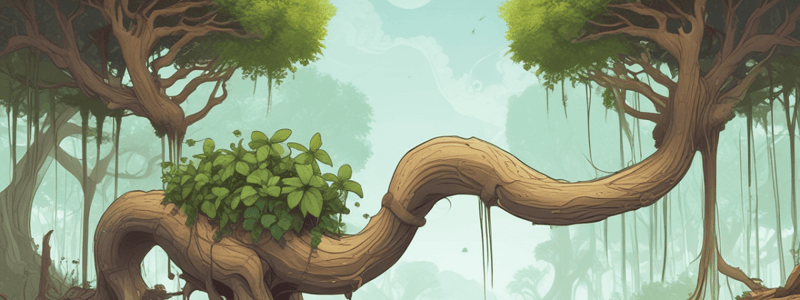Podcast
Questions and Answers
What best describes the role of guard cells in a plant?
What best describes the role of guard cells in a plant?
- They transport minerals throughout the plant.
- They facilitate the cohesion of water molecules.
- They control the opening and closing of stomata. (correct)
- They absorb water through osmosis.
What is the primary reason for plant stomata to close during drought conditions?
What is the primary reason for plant stomata to close during drought conditions?
- To optimize gas exchange.
- To prevent excess water loss. (correct)
- To increase the rate of photosynthesis.
- To facilitate nutrient uptake.
How do root hair cells facilitate the process of osmosis?
How do root hair cells facilitate the process of osmosis?
- By actively transporting water into the root.
- By providing a larger surface area for water absorption. (correct)
- By emitting water vapor into the air.
- By increasing the water potential in the soil.
Which of the following pairs of substances are primarily transported by plants?
Which of the following pairs of substances are primarily transported by plants?
What distinguishes cohesion from adhesion in plant physiology?
What distinguishes cohesion from adhesion in plant physiology?
What is transpiration primarily responsible for in plants?
What is transpiration primarily responsible for in plants?
Flashcards are hidden until you start studying
Study Notes
Plant Transportation and Adaptations
- Plants require water and minerals for efficient nutrient transport and survival.
- Water enters root hair cells through osmosis, a passive transport process driven by concentration gradients.
- Root hairs possess adaptations such as thin walls and a large surface area, enhancing their ability to absorb water effectively.
Cohesion-Tension Model
- The cohesion-tension model, explaining water movement in plants, was developed by scientists Dixon and Joly.
- This model illustrates how water molecules stick together (cohesion) and how they adhere to other surfaces, facilitating upward movement through plant tissues.
Transpiration and Stomata Function
- Transpiration refers to the loss of water vapor from the aerial parts of a plant, mainly through stomata.
- Stomata are small openings on plant surfaces controlled by guard cells, which regulate their opening and closing to balance water loss and gas exchange.
- Stomata close under high carbon dioxide concentrations and during drought conditions to conserve water.
- Stomata open when carbon dioxide levels drop, allowing for gas exchange and photosynthesis.
Gas Exchange Process
- Carbon dioxide enters stomata by diffusion, a process where molecules move from an area of higher concentration to one of lower concentration.
Modified Plant Structures
- Some plants have specialized structures for food storage:
- Carrots exemplify roots modified for storing nutrients.
- Potatoes serve as stems modified for food storage.
- Onions illustrate leaves modified to store energy.
Studying That Suits You
Use AI to generate personalized quizzes and flashcards to suit your learning preferences.




